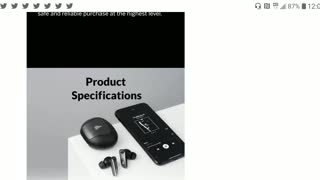Amazfit PowerBuds Pro Earbuds Debuts with ANC just upstaged Apple’s next AirPods
It has been rumored that the next version of Apple’s popular AirPods Pro true wireless earbuds will have fitness tracking features built-in. But why wait for an unknown amount of time (and money) when you can now order Amazfit’s PowerBuds Pro for just $150? They’re the first true wireless earbuds we’ve come across since Jabra’s 2017 Elite Sport that can track your heart rate and monitor your workouts. They come in white and will be available to pre-order starting July 15.
Amazfit is best known for its series of ultra-affordable fitness-oriented smartwatches, but the company clearly has its sights set on appealing to a much wider audience. The PowerBuds Pro possess a seemingly endless list of features, including active noise cancellation (ANC), transparency mode, customizable EQ and touch controls, IP55 dust and water protection, up to 30 hours of battery life when you include the charging case, Google FastPair compatibility, volume level monitoring, and in-ear detection.
They’ll keep tabs on your posture and nag you when you’ve been in a fixed position too long (if you want). The only feature that’s missing is wireless charging, but considering the PowerBuds Pro’s price, this seems like a reasonable omission given everything else on offer.
The in-ear heart rate sensor monitors heart rate during exercise. A tap on an earbud provides current heart rate status, and the Amazfit says the earbuds will play an alert when your exercise heart rate is too high (we assume you enter your personal data like age, sex, and weight in the free Zepp app)
For runners, the PowerBuds Pro can recognize when running starts and automatically start tracking relevant activity data.
It’s impossible to say how the PowerBuds Pro compare to the AirPods Pro in terms of ANC — it would be miraculous if they were as good. Amazfit claims they can cancel up to 40 decibels of sound, and you can choose from four noise cancellation modes — Indoor, Travel, Sports, and Adaptive. This doesn’t tell us whether it’s better for low or high frequencies or how well it can adapt to these different environments.
-
 11:48
11:48
Digital Trends
3 years agoApple AirPods Pro vs Bose QuietComfort Earbuds
194 -
 5:07
5:07
AV Atmos
3 years agoEdifier NeoBuds Pro earbuds Debuts and promises wireless hi-res audio for $99
141 -
 6:38
6:38
Digital Trends
3 years agoKlipsch T5 II True Wireless Earbuds Review | Put those AirPods down!
661 -
 4:14
4:14
AV Atmos
3 years agoUrbanista Seoul and Lisbon ANC TWS Debuts as the company's latest affordable wireless earbuds
25 -
 4:21
4:21
AV Atmos
3 years agoHiBy WH2 True Wireless Earphone Debuts as the company's new Flagship TWS Hybrid 1BA+1DD Earbuds
35 -
 0:32
0:32
KSHB
3 years agoIsbel, Brentz primed for MLB debuts with Royals
4 -
 7:46
7:46
Game On!
5 hours ago $0.34 earnedBLOCKBUSTER NFL trade! Titans trade Deandre Hopkins to the Chiefs!
2.86K1 -
 1:27:39
1:27:39
The Quartering
4 hours agoPoaching Tim Pool Staff, Trump Rogan Meltdown, Kamala Word Salad Fail & Major Censorship Exposed
48.4K38 -
 16:16
16:16
DeVory Darkins
4 hours ago $19.59 earnedSwing Voters DROP BOMB on Kamala's Campaign
42.5K31 -
 1:02:09
1:02:09
Russell Brand
6 hours agoJordan Peterson Part 1 - “We’re Heading Towards Dystopia, THIS Is What We Must Do Now” SF475
142K243